More than in any other country, Australia’s children and teenagers are affected by online bullying. Have you ever wondered how many individuals experience cyberbullying each day?
We have compiled horrifying cyberbullying data to raise awareness of this cruel phenomenon that destroys people’s lives. Let’s now go into the specifics!
Fascinating Cyberbullying Facts
- Young Australians reported being cyberbullied in 53% of cases.
- 79% of youngsters aged 10 to 18 have experienced online bullying
- Teenagers in Australia only reported online harassment to educational institutions 21% of the time.
- Fewer than half of Australian teenagers who experienced internet bullying confided in their family or friends.
- Most female victims of cyberbullying are younger women between 18 and 24.
- 37% of female internet users reported feeling physically intimidated.
- In Australia, 17.9% of cyberbullying incidents had racist undertones.
- In only 2020, Facebook eliminated more than 1.3 billion phony accounts.
- 30% of those bullied online had also been harassed at school.
- In 2019, 42.4% of Australian teenagers claimed to have seen cyberbullying.
General Cyberbullying Statistics
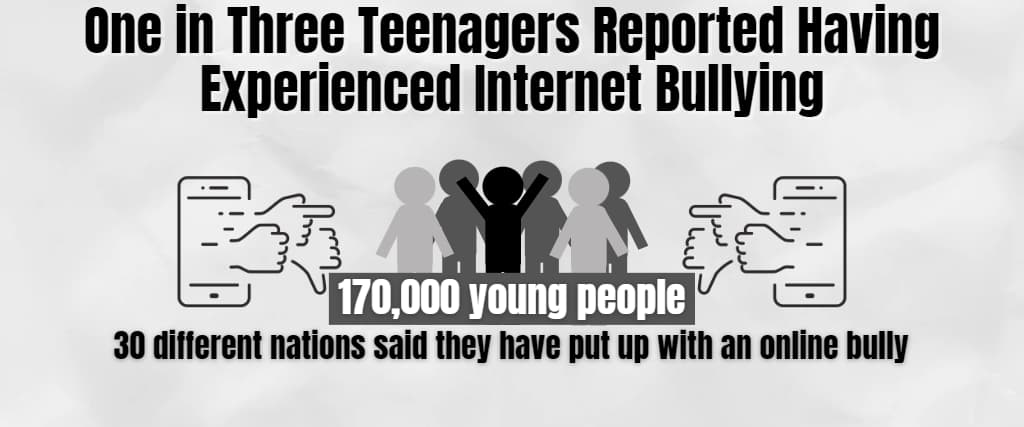
1. One in Three Teenagers Reported Having Experienced Internet Bullying
More than 170,000 young people from 30 different nations said they have put up with an online bully. It is around one-third of everyone took part in the UNICEF research. Bullying swiftly spreads beyond the confines of the computer screen and into people’s everyday lives.
Also, it has a significant psychological impact on teenagers, as one in five abandon school to avoid going through another unpleasant event due to online trolling.
2. Cyberbullying Victimization Rates Range From 13.99 to 57.5%
A part of 20 research examined the frequency of online bullying victimisation. Eleven national investigations found that cyberbullying perpetrators ranged from 6.3 to 32%, while victim rates for online harassment ranged from 14.6 to 52.2%.
But, when regional and local statistics were included, the victim rates skyrocketed to a terrifying proportion that varied between 13.99 and 57.5%, while the execution rates for cyberbullying ranged from 6.0 to 46.3%.
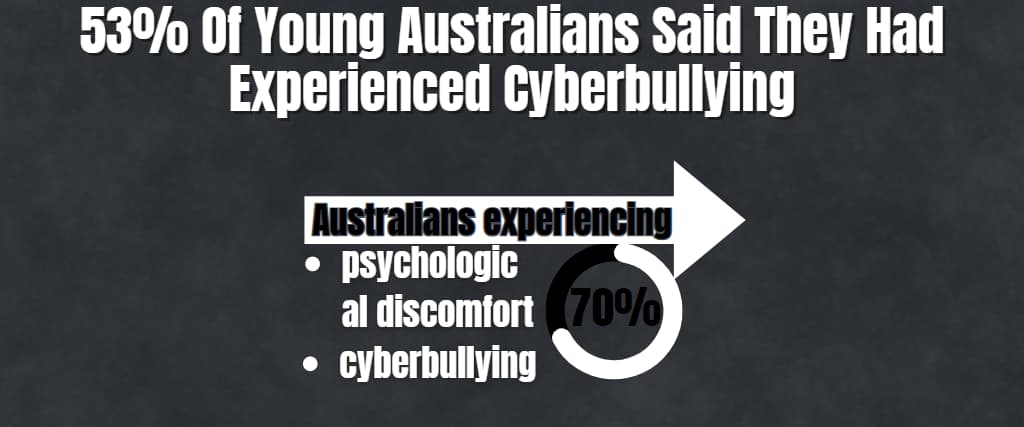
3. 53% Of Young Australians Said They Had Experienced Cyberbullying
According to the most recent National Mental Health Foundation report on bullying in Australia, over half of young Australians have encountered online abuse.
As 70% of young Australians experiencing, psychological discomfort reported experiencing cyberbullying at some time, cyberbullying significantly negatively influences mental health.
Cyberbullying is so pervasive that the NSW State Government, the Australian state with the highest crime rate, has the legal authority to pursue criminal charges against offenders who engage in intimidating, harassing, or insulting online behaviour.
4. Online Trolling Was Encountered by More Than One in Three Australians
How many individuals in Australia experience cyberbullying? A poll of 1,557 Australian employees revealed that nearly two-thirds of respondents had experienced online harassment. These results suggest that some 8.8 million Aussies are the targets of cyberbullying.
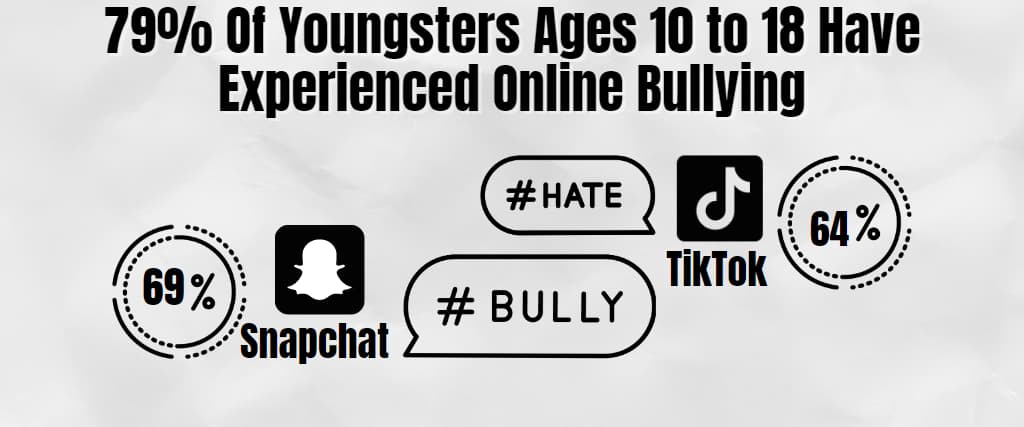
5. 79% Of Youngsters Ages 10 to 18 Have Experienced Online Bullying
Being one of the nation’s most widely used social media platforms, YouTube also draws the most online trolls. Moreover, Snapchat isn’t far behind, with 69% of young users reporting cyberbullying.
But, as new social media sites emerge, a concerning number of cyberbullies are joining them. At TikTok, 64% of users responded “yes” when asked if they had ever faced bullying on the app.
6. 44% Of Teenagers in Australia Experienced Some Online Adversity
A troubling 30% of kids who participated in the eSafety study had an online stranger approach them six months before September 2020. Men were more inclined to be threatened and subjected to abuse, while girls had a 9% higher likelihood of receiving texts from an unknown sender than boys.
Although 20% of people of both sexes received inappropriate and unwelcome content, gender had no bearing on whether they received unwanted explicit content.
7. Teenagers in Australia Reported Online Bullying to Educational Institutions in the Amount of 21%
Children don’t trust institutions to assist them in overcoming online assaults, according to statistics on cyberbullying. Instead, since victims who reported the harassment to a school or a website such as Facebook account for 21% each, they would prefer to put it in their own hands.
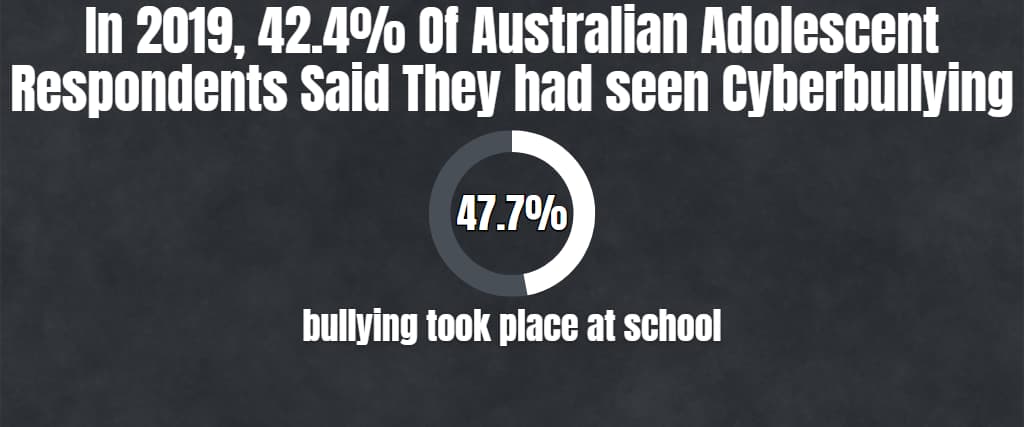
8. In 2019, 42.4% Of Australian Adolescent Respondents Said They had seen Cyberbullying
Most of the time, bullying took place at school, with over 47.7% of kids reporting that it had happened to someone they knew. Since over fifty per cent of those who took part had experienced online bullying, the percentages for online harassment were also exceptionally high.
9. 30% Of Victims of Cyberbullying Reported Being Harassed at School
Internet bullying directly impacts how pupils are treated by their peers; in some cases, it even works the other way around. For instance, a third of Australian teenagers said that bullying in between courses was directly responsible for their unpleasant online experience.
Yet, as people got older, the percentages dropped; 36% of tweens reported being bullied in real life. 20% of kids worldwide choose not to attend school due to internet bullying and its detrimental impact on their everyday life.
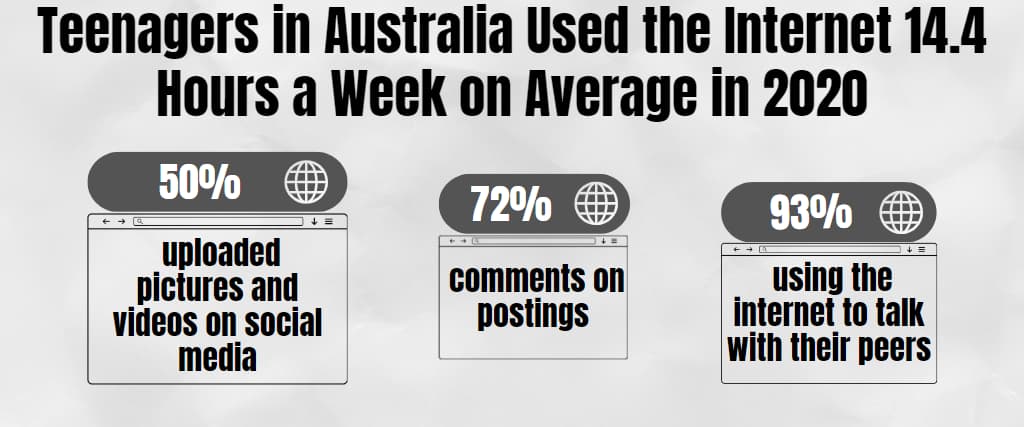
10. Teenagers in Australia Used the Internet 14.4 Hours a Week on Average in 2020
Teenagers in Australia use the internet for more than two hours per day, primarily to view videos and conduct online research on topics of interest. Australian youth watch web videos for two full days (48 hours) each month.
More than 50% of teenagers uploaded pictures and videos on social media, and 72% left comments on postings. Young Australians use social media platforms primarily for communication, with 93% using the internet to talk with their peers.
11. 11% Of Teenagers in Australia Have Emailed an Internet Stranger a Photo of Themselves
Teenagers are now more conscious of the dangers the internet may pose. Just 8% of youngsters have transmitted their personal information to strangers weekly, and only 12% of those strangers have ever been met in person.
However, 77% of adolescents would feel more at ease if their profiles on social media were instantly switched to the most private settings for users under 18. Moreover, 58% of teens believe they need to be educated more about how their data is shared, and they would feel more at ease.
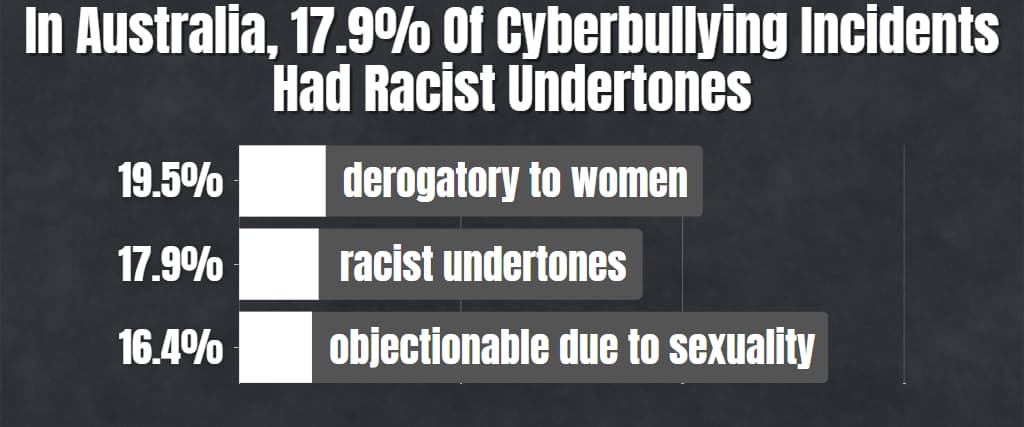
12. In Australia, 17.9% Of Cyberbullying Incidents Had Racist Undertones
Racially driven cyberbullying cases are second in popularity to gender-based hate among internet trolls. Also, the LGBTQ+ community experienced disrespectful and demeaning remarks because of their sexual orientation.
- content that is derogatory to women 19.5%
- Content with racist undertones 17.9%
- Content that is objectionable due to sexuality: 16.4%
13. Fewer Than Half of Australian Teenagers Who Experienced Internet Bullying Confided in Family or Friends
According to the most recent statistics on cyberbullying, kids typically keep their harassment to themselves, either out of humiliation (13%) or because they don’t think it’s a big concern (34%). Others even said they lacked the authority to effect change (21%).
As a result, they decide that blocking or unfriending is a better option. Just 43% of respondents claimed to have discussed the issue with friends or family, while 54% banned the troll as a self-help measure. Fewer teenagers used a kinder strategy, with 36% just unfriending the bully.
14. Most Women (39%) Who Experience Cyberbullying Do It on the Social Networking Site Facebook
Social media sites don’t do anything to stop sexual threats, body shaming, and abusive remarks against women from occurring on the internet. These are the social media platforms with the highest percentages of cyberbullying incidents against female users:
- Facebook – 39%
- Instagram – 23%
- WhatsApp – 14%
- Snapchat – 10%
- Twitter- 9%
- TikTok – 6%
The final one raises the most questions. TikTok has the most significant number of female users (61%), and the majority are between 18 and 24, even though there are fewer reported cases of harassment on this site.
15. In Australia, 46% Of Young People Used Smartphones in 2020
Australian youngsters are technologically addicted, and the number of individuals using cell phones from an early age has increased practically every year.
Australian children aged 6 to 13 who used smartphones in 2015 were 41% more likely to do so in 2018 and 2019 (47%).
Insignificantly, the number fell to 46% the following year.
Compared to the percentage of youngsters who use social networks on their parents’ cellphones, more than 50% of kids who had their smartphones were swiping through them.
Check out this post to learn how to lock specific mobile applications to keep kids from accessing inappropriate information.

16. In Only 2020, Facebook Deactivated More Than 1.3 Billion Fraudulent Accounts
That practically everyone has used Facebook at some point is not news. It will continue to be the most engaged social network globally, with 2.912 billion active users in January 2022.
Regrettably, only some people create an account to communicate with friends or publish material.
Facebook estimates that one in ten profiles are false, specifically designed to trick or intimidate individuals. Thus, the firm quadrupled the staff to 35,000 to promptly identify and erase bogus accounts.
17. Online Bullying of LGBTQ+ Youth Is Approximately Three Times as Likely
Queer adolescents are another target for internet trolls, according to cyberbullying statistics, which causes sadness in more than 50% of LGBTQ+ persons. However, many gay teenagers had suicidal ideas, with 35% saying they had considered suicide due to ongoing maltreatment.
18. More Than 40% Of Australians Who Experienced Cyberbullying in 2019 Had a Handicap
Adolescent cyberbullying significantly worsens the condition of persons who are physically and emotionally ill. 10% of schoolchildren in Australia had a handicap, and because they made up 43% of the victims, they experienced a lot of harassment.
In addition, teens from rural regions were 6% more likely to experience online harassment than bullied adolescents in metropolitan cities, who experienced cyberbullying at a rate of 19%.
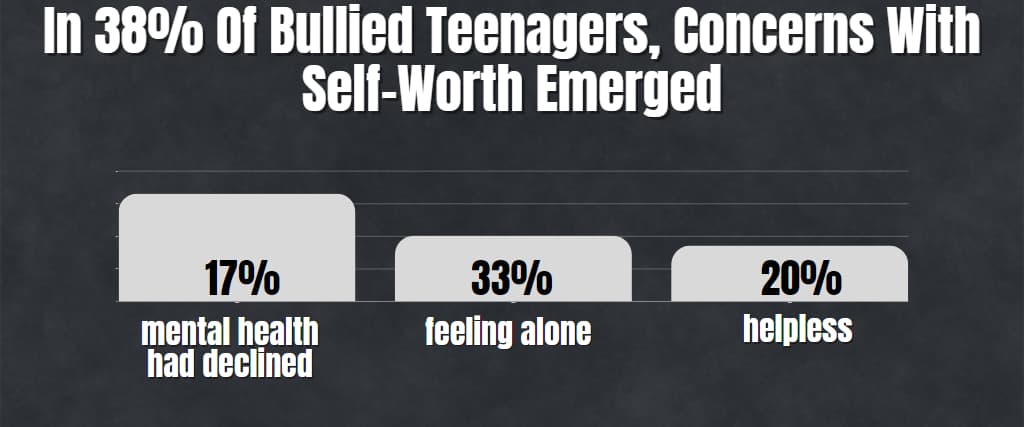
19. In 38% Of Bullied Teenagers, Concerns With Self-Worth Emerged
A sizable portion began questioning their value, feeling alone (33%) and helpless (20%). Moreover, exposure to online abuse may significantly negatively impact children’s mental health; 17% of those affected said that their mental health had declined.

20. In Australia, 80% Of People Were Aware of Cyberbullying
Australia does an excellent job of raising awareness of the harmful effects of internet harassment on both children and adults while not being the greatest at it.
The vast majority of Australians (77%) concur that internet bullying is a significant issue that mainly affects children and impacts many adults.
The nation gets a rather average awareness score worldwide, indicating that cyberbullying on social networks has become a significant conversation point.
The top 5 nations that have taken the most initiative to promote reform and cyber safety are as follows:
- Italy – 91%
- Sweden – 91%
- Chile – 89%
- South Africa – 88%
- Mexico – 87%
21. Online Harassment Has Affected 30% Of Australian Women
Three out of ten women reported having a bad online experience, making trolls more frequently target women than males. Younger women (18 to 24 years old) make up over half of the female victims of online harassment, and 37% reported feeling physically threatened.
Both offline and online bullying is more common towards women; according to a recent study, 23% of women reported experiencing workplace harassment, compared to only 16% of males.
Most Australian women believe that sexism is the root of the issue, with 42% reporting encounters with sexist remarks.
Bottom Line
According to statistics on cyberbullying, severe maltreatment may quickly cause melancholy, anxiety, and even suicidal tendencies, which can seriously harm a person’s mental health. Hence, remember that you may always report harmful online behaviour and look for help to stop it the next time someone mistreats you.